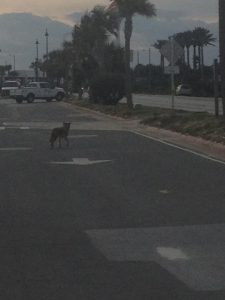It’s Halloween…
The time of year we think of werewolves, warlocks, witches, and full moon evenings. But there is another creature who likes to howl at the moon this time of year – the coyote.
Actually, coyotes howl all throughout the year, and they are not specifically howling at the moon. The name “coyote” is a Native American term meaning “singing dog”, or “barking dog”. They are famous for their early evening and early morning calls. Howls, barks, yelps, and yaps are very familiar to those living out west – and now for those living in the eastern United States.
It is believed the animal originated in the grasslands and deserts of the American southwest feeding on a variety of rodents. They have successfully dispersed across the country and can now be found in almost any habitat in the continental United States – including barrier islands. Though they owe much of their success to their ability to adapt to different foods and habitats, they also owe some of their success to humans. We have reduced their primary predators – bears, wolves, and mountain lions – to a level where they could move around more safely. There have been efforts to restore these predator populations in some localized areas of the U.S., but those are localized, and the process has been slow. All the while the coyote has enjoyed a more predator free world.
They are also opportunistic feeders. Though the bulk of their diet are small rodents, they are known to eat small birds, reptiles, amphibians, rabbits, squirrels, and even fruit. Out west, working in teams, they can take down larger prey – such as deer, and can do so here in the east as well. But their large prey targets are usually smaller members of the herd, sick, or old ones. They have also learned to feed on road kills of these animals.
Then there are humans. We provide an abundance of garbage which they have learned to scavenge through. Pet food left outside, gardens with produce, small livestock, and even pet cats and small dogs have been added to their menu. We have made their world much better.
With their numbers increasing in human populated areas, like Santa Rosa Island, people are becoming a bit nervous around them. The image of the toothed predator howling at the harvest moon on Halloween night in a pack with others makes us a bit uneasy. So, how dangerous are they?
Not very.
Coyotes are intelligent animals, and though they have learned to live and hunt within our neighborhoods, they are still afraid of us – they consider us trouble. On a recent trip to Colorado I was hiking down a trail and saw what appeared to be two sets of pointed ears in the grass. My guess was coyote but was not sure – so I began to walk towards them. Three coyotes immediately got up and moved off across the next ridge. They wanted nothing to do with me. And that is how it should be.
Those on barrier islands, like Santa Rosa, are no different. They are more active at dawn and dusk (crepuscular) and spend their days and late nights in a den somewhere. Occasionally people will see them in the middle of the day, or hear a yelp or howl around 2:00 AM, but it is more of a sunrise and sunset deal for them. They can remain motionless and undetected when people are around and will often run if we get too close. Many are not sure whether they are seeing a coyote or a German shepherd when they see one, both being about the same size. Coyotes tend to run with their tails down, unlike dogs and wolves who prefer to run with their tails up.
All of this said, there have been attacks on people – mostly out west and in southern California in particular. In most cases, the animals have either intentionally or unintentionally been fed by people. When this happens, they lose their fear of us and return for another easy meal. They are wild animals and being cornered by people or dogs (intentionally or unintentionally) can lead to defensive behaviors that could include attacks. To avoid this, we should not approach any coyote. Keep your trash secured and in cans that would be difficult for coyotes to access. Bring your pet food in at night and do not let pet cats and small dogs out in the evenings without supervision.
Bad encounters with these howling animals are rare, and with a little education and behavior changes on our part, should remain so.
Happy Halloween.
- Rattlesnakes on Our Barrier Islands; Part 1 Knowing the Snake - December 8, 2025
- Tips for Bear Encounters this Fall - November 10, 2025
- Pensacola Bay Invasive Species Summer Survey 2025 - November 3, 2025

